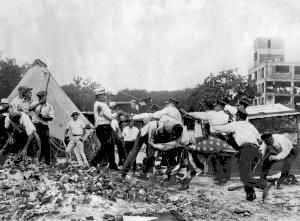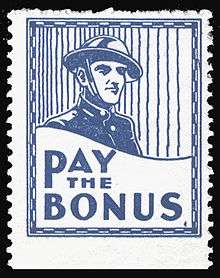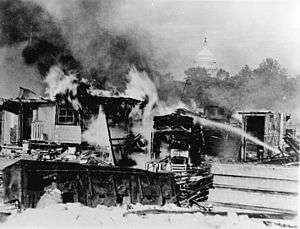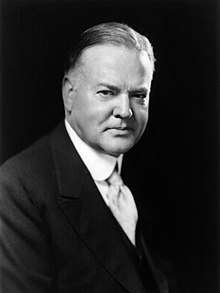Bonus Army
The Bonus Army was a group of 43,000 demonstrators – made up of 17,000 U.S. World War I veterans, together with their families and affiliated groups – who gathered in Washington, D.C. in mid-1932 to demand early cash redemption of their service certificates. Organizers called the demonstrators the "Bonus Expeditionary Force", to echo the name of World War I's American Expeditionary Forces, while the media referred to them as the "Bonus Army" or "Bonus Marchers". The demonstrators were led by Walter W. Waters, a former sergeant.
| Bonus Army Conflict | |||||||
|---|---|---|---|---|---|---|---|
 Bonus Army marchers (left) confront the police. | |||||||
| |||||||
| Belligerents | |||||||
| Bonus Army |
| ||||||
| Commanders and leaders | |||||||
| Walter W. Waters |
Herbert Hoover Douglas MacArthur George S. Patton | ||||||
| Strength | |||||||
|
17,000 veterans 26,000 others |
500 infantry 500 cavalry 6 M1917 light tanks 800 policemen | ||||||
| Casualties and losses | |||||||
| First day 2 dead; 55 injured,[1] total unknown | At least 69 police injured | ||||||
Many of the war veterans had been out of work since the beginning of the Great Depression. The World War Adjusted Compensation Act of 1924 had awarded them bonuses in the form of certificates they could not redeem until 1948. Each certificate, issued to a qualified veteran soldier, bore a face value equal to the soldier's promised payment with compound interest. The principal demand of the Bonus Army was the immediate cash payment of their certificates.
On July 28, U.S. Attorney General William D. Mitchell ordered the veterans removed from all government property. Washington police met with resistance, shot at the protestors, and two veterans were wounded and later died. President Herbert Hoover then ordered the U.S. Army to clear the marchers' campsite. Army Chief of Staff General Douglas MacArthur commanded a contingent of infantry and cavalry, supported by six tanks. The Bonus Army marchers with their wives and children were driven out, and their shelters and belongings burned.
A second, smaller Bonus March in 1933 at the start of the Roosevelt administration was defused in May with an offer of jobs with the Civilian Conservation Corps at Fort Hunt, Virginia, which most of the group accepted. Those who chose not to work for the CCC by the May 22 deadline were given transportation home.[2] In 1936, Congress overrode President Roosevelt's veto and paid the veterans their bonus nine years early.
Background

The practice of war-time military bonuses began in 1776, as payment for the difference between what a soldier earned and what he could have earned had he not enlisted. The practice derived from English legislation passed in the 1592–93 session of Parliament to provide medical care and maintenance for disabled veterans and bonuses for serving soldiers. Similar legislation for disabled veterans later only progressively passed by the North American colonies, beginning with Virginia in 1624.
In 1781, most of the Continental Army was demobilized. Two years later, hundreds of Pennsylvania war veterans marched on Philadelphia, then the nation's capital, surrounded the State House, where the U.S. Congress was in session, and demanded back pay. Congress fled to Princeton, New Jersey, and several weeks later, the U.S. Army expelled the war veterans from Philadelphia.
In August 1776, Congress adopted the first national pension law providing half pay for life for disabled veterans. Considerable pressure was applied to expand benefits to match the British system for serving soldiers and sailors but had little support from the colonial government until mass desertions at Valley Forge that threatened the existence of the Continental Army led George Washington to become a strong advocate. Congress progressively passed legislation from 1788 covering pensions and bonuses, eventually extending eligibility to widows in 1836.[3]
Before World War I, the soldiers' military service bonus (adjusted for rank) was land and money; a Continental Army private received 100 acres (40 ha) and $80.00 (2017: $1,968.51) at war's end, while a major general received 1,100 acres (450 ha). In 1855, Congress increased the land-grant minimum to 160 acres (65 ha), and reduced the eligibility requirements to fourteen days of military service or one battle; moreover, the bonus also applied to veterans of any Indian war. The provision of land eventually became a major political issue, particularly in Tennessee where almost 40% of arable land had been given to veterans as part of their bonus. By 1860, 73,500,000 acres (29,700,000 ha) had been issued and lack of available arable land led to the program's abandonment and replacement with a cash-only system. Breaking with tradition, the veterans of the Spanish–American War did not receive a bonus and after World War I, that became a political matter when they received only a $60 bonus. The American Legion, created in 1919, led a political movement for an additional bonus.[4]

On May 15, 1924, President Calvin Coolidge vetoed a bill granting bonuses to veterans of World War I, saying: "patriotism... bought and paid for is not patriotism." Congress overrode his veto a few days later,[4] enacting the World War Adjusted Compensation Act. Each veteran was to receive a dollar for each day of domestic service, up to a maximum of $500 (equivalent to $7,500 in 2019), and $1.25 for each day of overseas service, up to a maximum of $625 (equivalent to $9,300 in 2019).[5] Amounts of $50 or less were immediately paid. All other amounts were issued as Certificates of Service maturing in 20 years.[6]
There were 3,662,374 Adjusted Service Certificates issued, with a combined face value of $3.64 billion (equivalent to $54 billion in 2018).[7] Congress established a trust fund to receive 20 annual payments of $112 million that, with interest, would finance the 1945 disbursement of the $3.638 billion for the veterans. Meanwhile, veterans could borrow up to 22.5% of the certificate's face value from the fund; but in 1931, because of the Great Depression, Congress increased the maximum value of such loans to 50% of the certificate's face value.[8] Although there was congressional support for the immediate redemption of the military service certificates, Hoover and Republican congressmen opposed such action and reasoned that the government would have to increase taxes to cover the costs of the payout and so any potential economic recovery would be slowed.[9]
The Veterans of Foreign Wars continued to press the federal government to allow the early redemption of military service certificates.[10]
The first march of the unemployed was Coxey's Army in 1894, when armies of men from various regions streamed to Washington as a "living petition" to demand that the federal government create jobs by investing in public infrastructure projects.[11] In January 1932, a march of 25,000 unemployed Pennsylvanians, dubbed "Cox's Army", had marched on Washington, D.C., the largest demonstration to date in the nation's capital, setting a precedent for future marches by the unemployed.
March

Most of the Bonus Army (Bonus Expeditionary Force or BEF) camped in a "Hooverville" on the Anacostia Flats, a swampy, muddy area across the Anacostia River from the federal core of Washington, just south of the 11th Street Bridges (now Section C of Anacostia Park). Approximately 10,000 veterans, women and children lived in the shelters that they built from materials dragged out of a junk pile nearby, which included old lumber, packing boxes, and scrap tin covered with roofs of thatched straw.[12] The camps were tightly controlled by the veterans, who laid out streets, built sanitation facilities, and held daily parades. To live in the camps, veterans were required to register and to prove they had been honorably discharged. The Superintendent of the D.C. Police, Pelham D. Glassford, worked with camp leaders to maintain order.
On June 15, 1932, the US House of Representatives passed the Wright Patman Bonus Bill to move forward the date for World War I veterans to receive their cash bonus.[13] The Bonus Army massed at the U.S. Capitol on June 17 as the U.S. Senate voted on the Bonus Bill. The bill was defeated by a vote of 62–18.[14]
Police shooting

On July 28, 1932, President Hoover ordered the Secretary of War to disperse the protesters. Towards the late afternoon, cavalry, infantry, tanks and machine guns pushed the "Bonusers" out of Washington. [15] When the veterans moved back into the camp, police drew their revolvers and shot at the veterans, two of whom, William Hushka and Eric Carlson, died later.[16][1]
William Hushka (1895–1932) was an immigrant to the United States from Lithuania. When the US entered World War I in 1917, he sold his butcher shop in St. Louis, Missouri, and joined the army. After the war, he lived in Chicago.[1]
Eric Carlson (1894–1932) was a veteran from Oakland, California who fought in the trenches of France in World War I.[1][17][18] He was interred in Arlington National Cemetery.[19]
On July 28 under prodding from the White House the D.C. Commissioners ordered Glassford to clear their buildings, rather than letting the protesters drift away as he had previously recommended. When the two veterans were shot, the Commissioners asked the White House for federal troops. Hoover passed the request to Secretary of War Hurley, who told MacArthur to take action.
Army report
An Army intelligence report claimed that the BEF intended to occupy the Capitol permanently and instigate fighting, as a signal for Communist uprisings in all major cities. It also conjectured that at least part of the Marine Corps garrison in Washington would side with the revolutionaries, hence Marine units eight blocks from the Capitol were never called upon. The report of July 5, 1932 by Conrad H. Lanza in upstate New York was not declassified until 1991.[20]
Army intervention
At 1:40 pm MacArthur ordered General Perry Miles to assemble troops on the Ellipse immediately south of the White House. Within the hour the 3rd Cavalry led by Patton, then a Major, crossed the Memorial Bridge, with the 12th Infantry arriving by steamer about an hour later. At 4 pm Miles told MacArthur that the troops were ready, and MacArthur (like Eisenhower, by now in service uniform), said that Hoover wanted him "on hand" to "take the rap if ..."
Although the troops were ready, Hoover twice sent instructions to MacArthur not to cross the Anacostia bridge that night, both of which were ignored. Shortly after 9 pm, MacArthur ordered Miles to cross the bridge and evict the Bonus Army from its encampment.[21]
At 4:45 pm. commanded by General Douglas MacArthur, the 12th Infantry Regiment, Fort Howard, Maryland, and the 3rd Cavalry Regiment, supported by six M1917 light tanks commanded by Maj. George S. Patton, formed in Pennsylvania Avenue while thousands of civil service employees left work to line the street and watch. The Bonus Marchers, believing the troops were marching in their honor, cheered the troops until Patton ordered the cavalry to charge them, which prompted the spectators to yell, "Shame! Shame!"

After the cavalry charged, the infantry, with fixed bayonets and tear gas (adamsite, an arsenical vomiting agent) entered the camps, evicting veterans, families, and camp followers. The veterans fled across the Anacostia River to their largest camp, and Hoover ordered the assault stopped. MacArthur chose to ignore the president and ordered a new attack, claiming that the Bonus March was an attempt to overthrow the US government. 55 veterans were injured and 135 arrested.[1] A veteran's wife miscarried. When 12-week-old Bernard Myers died in the hospital after being caught in the tear gas attack, a government investigation reported he died of enteritis, and a hospital spokesman said the tear gas "didn't do it any good."[22]
During the military operation, Major Dwight D. Eisenhower, later the 34th president of the United States, served as one of MacArthur's junior aides.[23] Believing it wrong for the Army's highest-ranking officer to lead an action against fellow American war veterans, he strongly advised MacArthur against taking any public role: "I told that dumb son-of-a-bitch not to go down there," he said later. "I told him it was no place for the Chief of Staff."[24] Despite his misgivings, Eisenhower later wrote the Army's official incident report that endorsed MacArthur's conduct.[25]
Aftermath
Joe Angelo, a decorated hero from the war who had saved Patton's life during the Meuse-Argonne offensive on September 26, 1918, approached him the day after to sway him. Patton, however, dismissed him quickly. This episode was said to represent the proverbial essence of the Bonus Army, each man the face of each side: Angelo the dejected loyal soldier; Patton the unmoved government official unconcerned with past loyalties.[26]
Though the Bonus Army incident did not derail the careers of the military officers involved, it proved politically disastrous for Hoover, and it is considered a contributing factor to his losing the 1932 election in a landslide to Franklin D. Roosevelt.[27]
Police Superintendent Glassford was not pleased with the decision to have the Army intervene, believing that the police could have handled the situation. He soon resigned as superintendent.
MGM released the movie Gabriel Over the White House in March 1933, the month Roosevelt was sworn in as president. Produced by William Randolph Hearst's Cosmopolitan Pictures, it depicted a fictitious President Hammond who, in the film's opening scenes, refuses to deploy the military against a march of the unemployed and instead creates an "Army of Construction" to work on public works projects until the economy recovers.[28] First Lady Eleanor Roosevelt judged the movie's treatment of veterans superior to Hoover's.[29]
During the presidential campaign of 1932, Roosevelt had opposed the veterans' bonus demands.[30] A second bonus march planned for the following year in May by the "National Liaison Committee of Washington," disavowed by the previous year's bonus army leadership, demanded that the Federal government provide marchers housing and food during their stay in the capital.[31] Despite his opposition to the marchers' demand for immediate payment of the bonus, Roosevelt greeted them quite differently than did Hoover. The administration set up a special camp for the marchers at Fort Hunt, Virginia, providing forty field kitchens serving three meals a day, bus transportation to and from the capital, and entertainment in the form of military bands.[32]
Administration officials, led by presidential confidant Louis Howe, tried to negotiate an end to the protest. Roosevelt arranged for his wife, Eleanor, to visit the site unaccompanied. She lunched with the veterans and listened to them perform songs. She reminisced about her memories of seeing troops off to World War I and welcoming them home. The most that she could offer was a promise of positions in the newly created Civilian Conservation Corps (CCC).[29] One veteran commented, "Hoover sent the army, Roosevelt sent his wife."[33] In a press conference following her visit, the First Lady described her reception as courteous and praised the marchers, highlighting how comfortable she felt despite critics of the marchers who described them as communists and criminals.[29]
Roosevelt later issued an executive order allowing the enrollment of 25,000 veterans in the CCC, exempting them from the normal requirement that applicants be unmarried and under the age of 25.[34] Congress, with Democrats holding majorities in both houses, passed the Adjusted Compensation Payment Act in 1936, authorizing the immediate payment of the $2 billion in World War I bonuses, and then overrode Roosevelt's veto of the measure.[35] The House vote was 324 to 61,[36] and the Senate vote was 76 to 19.[37]
See also
- Coxey's Army
- Fry's Army
- List of rallies and protest marches in Washington, D.C.
- On-to-Ottawa Trek by Canadian veterans, 1935
References
- "Heroes: Battle of Washington". Time. August 8, 1932. Archived from the original on October 25, 2008. Retrieved August 30, 2011.
Last week William Hushka's Bonus for $528 suddenly became payable in full when a police bullet drilled him dead in the worst public disorder the capital has known in years.
- "'Take Job in the Forest or Go Home' Is Alternative Given to Bonus Boys", Middlesboro (Kentucky) Daily News, May 17, 1933, p. 1; "Bonus Marchers Weaken; Accept Jobs in Ax Corps", Milwaukee Journal, May 20, 1933, p. 1
- Graves, Will. "Pension Acts An Overview of Revolutionary War Pension and Bounty Land Legislation and the Southern Campaigns Pension Transcription Project". Southern Campaigns Revolutionary War Pension Statements & Rosters. Retrieved November 29, 2017.
- David Greenberg, Calvin Coolidge (NY: Henry Holt, 2006), 78–79
- Federal Reserve Bank of Minneapolis. "Consumer Price Index (estimate) 1800–". Retrieved January 1, 2020.
- Dickson and Allen, 29
- Thomas, Ryland; Williamson, Samuel H. (2019). "What Was the U.S. GDP Then?". MeasuringWorth. Retrieved April 6, 2019. United States Gross Domestic Product deflator figures follow the Measuring Worth series.
- Dickson and Allen, 37–38
- Dickson and Allen, 34
- Stephen R. Ortiz, "The 'New Deal' for Veterans: The Economy Act, the Veterans of Foreign Wars, and the Origins of the New Deal," Journal of Military History, vol. 70 (2006), 434–45
- Donald L. McMurry, "Coxey's Army", 1930.
- "'The Bonus Army' Eyewitness to History (2000)".
- Glass, Andrew (2009). "House passes bonus bill for WWI veterans, June 15, 1932". Politico. Retrieved December 20, 2013.
- Staff Correspondent (June 18, 1932). "Senate Defeats Bonus Despite 10,000 Veterans Massed Around Capitol". The New York Times (27, 174). Retrieved December 26, 2018.
- "The Bonus Army". Encyclopedia.com.
- "Veteran dies of wounds". The New York Times. August 2, 1932. Retrieved August 30, 2011.
- Mentioned in "The March of the Bonus Army" video, 30 min. Retrieved from answer.com 2011-2-4.
- "Bonus Army Spectacle, U.S. Capital, 1932: What Really Happened. Section VI. Two Shootings at Glassford Camp". Suburban Emergency Management Project (SEMP), Biot Report #635. July 18, 2009. Archived from the original on July 30, 2009. Retrieved February 8, 2011.
- "Bonus Expeditionary Force Martyrs Hushka & Carlson (1932)". DC Labor Map. Retrieved February 8, 2011.
- Lisio, Donald J. “A Blunder Becomes Catastrophe: Hoover, the Legion, and the Bonus Army.” The Wisconsin Magazine of History, vol. 51, no. 1, 1967, p. 40 JSTOR 4634286
- Smith, Jean Edward (2012). Eisenhower in War and Peace. New York: Random House. pp. 109–13. ISBN 978-0-679-64429-3.
- Dickson and Allen, 182–83
- Dickson and Allen, 170–74, 180
- Wukovits, John F. (2006). Eisenhower. New York: Palgrave Macmillan. p. 43. ISBN 0-230-61394-2. Retrieved June 15, 2011.
- D'Este, Carlo (2002). Eisenhower: A Soldier's Life. New York: Henry Holt & Co. p. 223. ISBN 0-8050-5687-4. Retrieved June 15, 2011.
- Hirshson, Stanley P. General Patton. Harper Collins Publishers 2002. New York.
- Kingseed, Wyatt (June 2004). "The 'Bonus Army' War in Washington". American History magazine. Retrieved January 31, 2018 – via Historynet.com.
- Gabriel Over the White House on IMDb
- Blanche Wiesen Cook, Eleanor Roosevelt (NY: Viking, 1999), vol. 2, 44–46
- "Governor Lays Plans for Trip". The New York Times. October 17, 1932. Retrieved December 18, 2010.
- "New Bonus March Starts Tomorrow" (PDF). New York Times. May 9, 1933. Retrieved December 26, 2018.
- Staff Correspondent (May 15, 1933). "Bonus Army Row Finally Adjusted". New York Times (LXXXII 27, 505). Retrieved December 26, 2018.
- Jenkins 2003, p. 63.
- Brands, H. W. (2009). Traitor to His Class: The Privileged Life and Radical Presidency of Franklin Delano Roosevelt. p. 391. ISBN 9780307277947.
- "Bonus Bill Becomes Law". The New York Times. January 28, 1936. Retrieved December 20, 2010.
- "House Swiftly Overrides Bonus Veto by Roosevelt". The New York Times. January 25, 1936. Retrieved September 3, 2011.
- "Bonus Bill Becomes Law". The New York Times. January 28, 1936. Retrieved September 3, 2011.
Sources
- Burner, David. (1979). Herbert Hoover: A Public Life. New York: Alfred A. Knopf. ISBN 0-394-46134-7.
- Daniels, Roger. (1971). The Bonus March: An Episode of the Great Depression. Westport, CT: Greenwood Publishing. ISBN 0837151740
- Dickson, Paul, and Thomas B. Allen. (2004). The Bonus Army: An American Epic. New York: Walker and Company. ISBN 0-8027-1440-4.
- Dickson, Paul, and Thomas B. Allen. "Marching On History," in Smithsonian, February 2003
- James, D. Clayton. (1970). The Years of MacArthur, Volume I, 1880–1941. Boston: Houghton Mifflin. OCLC 36211265
- Laurie, Clayton D. and Ronald H. Cole. (1997). The Role of Federal Military Forces in Domestic Disorders, 1877–1945. Washington, DC: Center of Military History
- Jenkins, Roy (2003). Franklin Delano Roosevelt. New York: Times Books. ISBN 9780805069594.CS1 maint: ref=harv (link)
- Lisio, Donald J. (1974). The President and Protest: Hoover, Conspiracy, and the Bonus Riot. Columbia, MO: University of Missouri Press. ISBN 082620158X
- Smith, Richard Norton. (1984). An Uncommon Man: The Triumph of Herbert Hoover. New York: Simon & Schuster. ISBN 0-671-46034-X.
- Liebovich, Louis W. (1994). Bylines in Despair: Herbert Hoover, the Great Depression, and the U.S. News Media ISBN 0-275-94843-9
- Bennett, Michael J. (1999). When Dreams Come True: The GI Bill and the Making of Modern America ISBN 1-57488-218-X
- Perret, Geoffrey (1996). "MacArthur and the Marchers" in MHQ: the Quarterly Journal of Military History. Vol 8, No 2 American Historical Publication, Inc
Further reading
- Morrow, Felix. (1932). The Bonus March. International Pamphlets No. 31. New York: International Publishers. OCLC 12546840
- Ortiz, Stephen R. 2006. "Rethinking the Bonus March: Federal Bonus Policy, the Veterans of Foreign Wars, and the Origins of a Protest Movement". Journal of Policy History. 18, no. 3: 275–303.
- Rawl, Michael J. (2006). Anacostia Flats. Baltimore: Publish America. ISBN 978-1-413-79778-7.
- Smith, Gene. (1970). The Shattered Dream: Herbert Hoover and the Great Depression. New York: William Morrow and Company. OCLC 76078
External links
| Wikimedia Commons has media related to Bonus Army. |
- Sheilah Kast (February 13, 2005). "Soldier Against Soldier: The Story of the Bonus Army". NPR: Weekend Edition Sunday.
- The Bonus Army (EyeWitness to History)
- Vets Owe Debt to WWI's "Bonus Army from military.com
- FBI file on the Bonus Army
- The Sad Tale of the Bonus Marchers
- Memory: The Bonus Army March, Library of Congress
- Paul Dickson & Thomas B. Allen on The Bonus Army: An American Epic, a lecture recorded at the Pritzker Military Museum & Library
